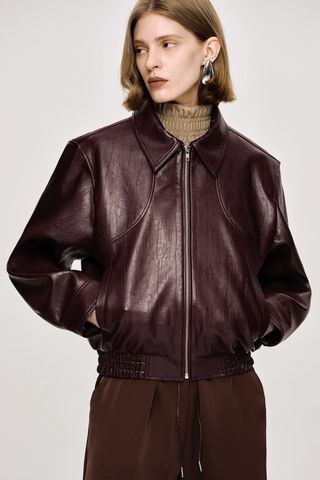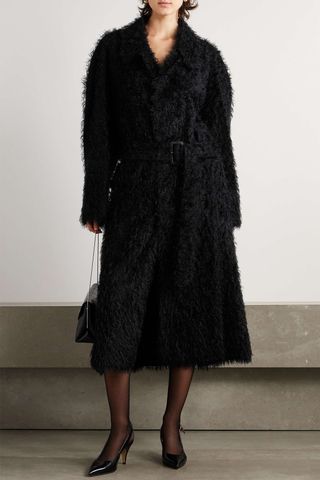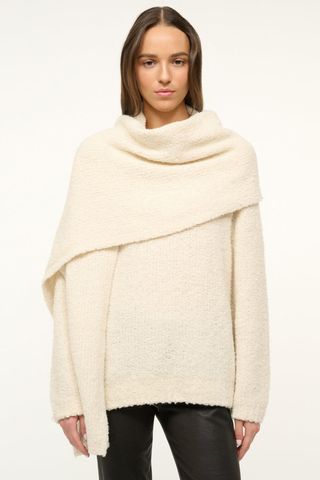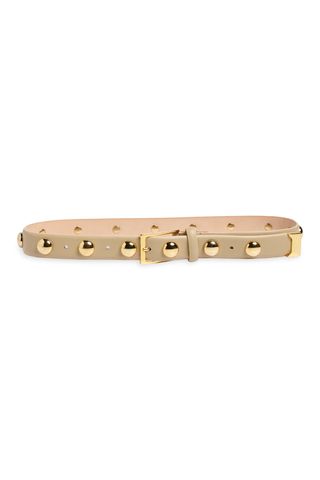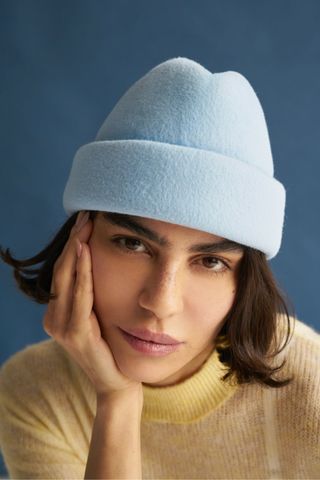Let’s be honest: Focusing on fashion right now can feel, well, downright frivolous. With so much political instability around the globe and many struggling to pay for household necessities, shopping isn’t necessarily a top priority at the moment. However, that doesn’t mean that everyone has decided to opt out of shopping altogether. If anything, the current state of the world has cemented the importance of making pragmatic purchases. Of course, it’s far more fun to indulge in the fantasy that we can buy into new trends every few months. But in this economy? It’s best to play the long game. For some, that translates into only investing in foundational basics, which is an admirable approach, but realistically, not everyone likes adhering to a capsule wardrobe. Therefore, you have to find a shopping strategy that reflects your style, budget, and values.
Although that differs for everyone, one of the easiest ways to begin to think long-term isn’t to swear off trends altogether but to be intentional about the ones we buy. The secret to being more pragmatic with your purchases comes down to choosing trends that can not only be incorporated into your current closet easily but will also be around for a while. It might seem like an oxymoron considering the very nature of trends, but the truth is that there are always a few that carry over from season to season. In an effort to help you identify the best fashion trends to invest in for the long haul, we spent hours sifting through the fall 2024 and spring 2025 collections. Ahead, we’re sharing 10 trends that are easy to incorporate into any wardrobe, transition well from winter to spring, and are safe long-term investments. No matter how much the world is currently shifting around us, these trends will stick around for a while.
(Image credit: Launchmetrics Spotlight; PICTURED: The Attico F/W 24; Michael Kors F/W 24; Lacoste F/W 24; Baum und Pferdgarten S/S 25; Burberry S/S 25; Brandon Maxwell S/S 25)
Unless you’ve been off the grid, the current cultural obsession with all things sports-adjacent hasn’t blindsided you. After all, we’ve seen it reflected in the box-office success of films such as Challengers or the sudden obsession with Formula One on social media. However, the cultural influence of sports reaches farther than one might suspect, as we’ve seen it infiltrate the fashion world, too. Although these two worlds have always influenced each other—refer to the rise of sneakerhead culture, the creation of tunnel style, and even beloved style icons such as Victoria and David Beckham—recently, we’ve seen sports aesthetics play an even more pivotal role on the runway. No other long-haul trend is more symbolic of that relationship than what we’re calling “Sporty Spice”: the styling of sportswear and eveningwear together as a way to give pragmatic pieces a playful spin.
We saw that approach across F/W 24 and S/S 25 collections in the form of slip skirts styled with puffer coats or sequin gowns peeking out underneath trench coats (see: Michael Kors, Burberry, The Attico, and Brandon Maxwell). Even the more obvious nods to sportswear were glamorized, as Lacoste F/W 24 styled a sheer embellished top, satin skirt, and satin trench coat with a sports bra and retro sneakers. While at Baum und Pferdgarten’s S/S 25 runway show, sportswear items (such as polos, loafers, and sweatshirts) felt far spicier when worn with sheer sequin seperates and sparkly clutch bags that resembled the shape of soccer balls. Each of these collections proved that eveningwear isn’t something we should be sidelining but rather giving it a “second quarter” by styling it with sportswear. It’s a combination that’s a game changer for sure.

(Image credit: Launchmetrics Spotlight; Pictured: Dries Van Noten F/W 24; Gucci F/W 24; Bottega Veneta S/S 25; Michael Kors S/S 25; Fendi F/W 24; Victoria Beckham S/S 25)
If you follow seasonal trends, then it should come as no surprise that a few shades always reign supreme on the runway. However, there’s one trend that’s seemingly emerged from out of the blue that we’re dubbing “color theory”—i.e., styling contrasting shades together. Although the concept of color-blocking isn’t revolutionary by any means, it’s worth considering the choke hold “quiet luxury” had on collections over the past few seasons. With stark minimalism reigning supreme for so long, color-blocking feels like a complete vibe shift. But we’d argue that makes the trend a compelling investment, as designers made a seemingly “old” trend feel contemporary throughout their F/W 24 and S/S 25 collections. Most notably, the focus seemed to be less centered on creating the most visible contrast through unlikely combinations but instead styling the season’s biggest shades together. We saw that approach reflected across fall and spring collections in which looks were awash with variations of burgundy, tangerine, olive green, chocolate brown, dove gray, eggplant, and navy.
While designers still drew from the original idea of color theory, they did so in the most unexpected ways. For example, suiting was made brighter by styling vibrant boxy blazers and bomber jackets with contrasting tailored trousers at Dries Van Noten, Michael Kors, and Victoria Beckham. Similarly, the concept of mismatched separates was spotted in Bottega Veneta’s S/S 25 collection, in which a model sauntered down the runway in a cozy chocolate-brown sweater with a ruffled tangerine skirt. Beyond playing with color-blocking through top-and-bottom pairings, some took it a step further by using accessories such as boots, bags, and even belts as a way to dial up the contrast (see: Gucci’s and Fendi’s fall collections). By embracing stying shades in this way across their collections, designers made a case for coloring outside the lines.

(Image credit: Launchmetrics Spotlight; PICTURED: Tory Burch F/W 24; Gucci Resort S/S 25; Fendi F/W 24; Bottega Veneta S/S 24; Coach F/W 24; Prada S/S 25)
If you thought you were the only person who struggled to pick out which trends to invest in for the long haul, think again. Across the F/W 24 and S/S 25 runway shows, we saw designers embrace the motto “more is more” in every aspect of their collections—from the color palettes to the handbags. The latter was arguably the best example of the more maximalist approach we’ve seen emerge recently, as designers didn’t stick to a single bag silhouette but styled bags of different sizes, shades, and shapes together. While the concept of carrying “more baggage” might be bad in broader pop culture, designers proved that doubled-up bags are not only the perfect way to inject personality into your wardrobe without purchasing a ton of new things but also pretty pragmatic.
For example, at Coach’s F/W 24 show, the classic oversize carryall was made way cooler by being styled with bag charms, baseball hats, and, most importantly, other smaller purses. Although Coach’s fall show was by far the most maximalist example of this handbag trend, other houses embraced it in their own ways—e.g., Fendi’s fall runway show and Prada’s spring show featured looks in which smaller and larger versions of their most famous bags were worn together. At the same time, Tory Burch created bags that crafted an optical illusion of multiple handbags stacked on each other without the extra baggage in their fall collection. And then, there were Gucci’s and Bottega Veneta’s spring shows, which offered up the most pragmatic version of this trend in the form of oversize totes that resembled grocery bags carried with smaller handbags. By exploring variations of maximalism through bag silhouettes and styling, designers proved that sometimes the better choice in life is not to choose at all.

COACH
Soft Empire Carryall

(Image credit: Launchmetrics Spotlight; Pictured: 16Arlington F/W 24; Tory Burch F/W 24; 3.1 Phillip Lim S/S 25; Alaïa F/W 24; Bottega Veneta S/S 25; Khaite S/S 25)
It doesn’t take a rocket scientist to realize that when temperatures begin to drop, thicker textiles start to trend. From faux fur to brushed cashmere, our cold-weather wardrobes are seemingly incomplete without rich textures. However, we’d argue that the quiet luxury movement made sensory details all the more important in recent seasons. Hear us out: No longer are we in an age of buying into every single trend but rather those that actually make us feel good. Frankly, there’s no better embodiment of that ethos than designers’ embrace of tactile textures throughout the F/W 24 and S/S 25 collections. It seemed that so much of the driving inspiration was to create clothing that not only was comforting to the touch but also cultivated a sense of emotional comfort. In short, the assignment was all about reimagining simple silhouettes to spark joy. That aim was achieved by embracing outside-the-ordinary textures in their collections—think prickly tensile, soft feathers, draped fringe, and crocheted appliqués.
In the fall runway shows of 16Arlington and Tory Burch, we saw that approach embodied in multiple looks that featured coats, skirts, and scarves made from semi-metallic tensile. While at Alaïa’s fall show, yarn was delicately draped to create intricate fringe dresses, skirts, and trousers that twisted and turned while models walked down the runway. Similarly, at Khaite’s spring show, hand-knitted crochet balls adorned a skirt that bounced as a model walked. However, the best possible examples were the themes of 3.1 Phillip Lim’s and Bottega Veneta’s spring shows, both of which were reflective of how they’ve experienced joy over the years—i.e., Phillip Lim’s collection was an homage to the cheerful moments that they’ve experienced since the brand celebrated it’s 20th anniversary. While at Bottega Veneta, Matthieu Blazy was how our relationship with dressing shifts as we age and the notion of bringing back childlike joy when it comes to our closets. Through exploring each of these themes through soft fringe, 3D appliqués, and even feathers, these collections reminded us that our clothing should make us feel good (in every way).

(Image credit: Launchmetrics Spotlight; PICTURED: Del Core S/S 25; Gauchere F/W 24; Brandon Maxwell S/S 25; Toteme S/S 25; Saint Laurent F/W 24; 16Arlington F/W 24)
Akin to textures’ continued relevance over time, there’s another trend that’s managed to transcend seasonality: sheer clothing. It may come as a surprise to some that designers would dare to show anything remotely opaque, especially in the colder seasons. Nevertheless, we’ve seen sheer clothing cemented as a year-round trend over the past few seasons. In part, that’s due to the trend’s continued relevance in collections, including the more recent F/W 24 and S/S 25 shows. But more realistically, it’s because we’ve seen this seemingly “impractical” trend shift to being, dare we say, semi-sensible in recent seasons. Unlike previous iterations of this trend, which relied upon the shock value of a “naked dress,” designers moved past the technicality of these sheer textiles by styling them in unexpected ways. That shift was most notably reflected in Saint Laurent’s F/W 24 and Toteme’s S/S 24 shows, which featured looks in which sheer blouses were styled over sheer skirts and stockings to create a smoke-and-mirrors effect.
Another example of how sheer clothing was made more sensible was through the way designers styled it with everyday staples such as an oversize leather blazer or a cozy black sweater (see: Gauchere’s and 16Arlington’s fall shows). Even beyond styling, there was seemingly an understanding across the board that for this trend to stay relevant in the long haul, they’d need to shift how people can incorporate this trend into their lives. In all honesty, sheer clothing can be stressful to adopt. However, designers made the prospect of embracing this trend more enjoyable by using opaque textiles not as a base layer but as something to be layered on top as a way to add visual interest—e.g., an organza white trench was layered over a dress at Del Core’s spring show. Similarly, a navy blue miniskirt and matching tank top had a sheer overlay on Brandon Maxwell’s spring runway. Whether through creative styling or well-designed separates, collections showed that embracing this trend doesn’t need to be stressful; you can find sheer joy in the process.

NakedCashmere
Silk Organza Skirt

(Image credit: Launchmetrics Spotlight; PICTURED: Carven F/W 24; Bottega Veneta F/W 24; Ferrari S/S 25; Philosophy Di Lorenzo Serafini F/W 24; Gucci S/S 25; Del Core S/S 25)
We know what you’re thinking: Gloves? Really? What groundbreaking reporting. Of course, it’s a given that this winter-ready accessory would come back around once the temperatures drop. But how this “boring” accessory was made bold again across recent collections can’t be ignored. It wasn’t just that designers incorporated gloves into their runway looks; they made it the focal point. That shift feels radical considering that accessories are often an afterthought or, at the very least, deemed unimportant compared to other trends. However, recent seasons have slowly shifted that narrative, as designers have leaned into using smaller details to make their collections stand out—a lesson we could all learn from. No other recent trend quite reflects that shift like the embrace of leather gloves in F/W 24 and S/S 25 collections. Some designers used the accessory as a way to lean into the collection’s theme, while others used the accessory to play with color-blocking.
A prime example of the latter would be Bottega Veneta’s fall show, which played with contrasting earth tones by styling vibrant orange gloves with a tan trench coat, a red button-down, and a green turtleneck. Similarly, at Philosophy di Lorenzo Serafini’s fall show, color-blocking manifested in the way models carried (not wore) colorful leather gloves in their hands as they held contrasting clutch bags. Even in Del Core’s spring collection, the accessory was used in a similar fashion: Sophisticated black coats and semi-sheer gowns were all styled with colorful opera gloves. Beyond being a way to play with color, gloves captured more of the thematic elements of collections—e.g., the “swan fashion” aesthetic appeared in ’60s-inspired elements sprinkled throughout Carven’s fall show. Whether through furthering the collection’s narrative or simply dialing up the contrast, leather gloves had a hand in showing the power of styling these past two seasons. If anything, the trend proves that we don’t necessarily need to buy entirely new wardrobes, just a few trends that can fit into them like a glove.

Saks Off 5th
Bruno Magli Leather Gloves
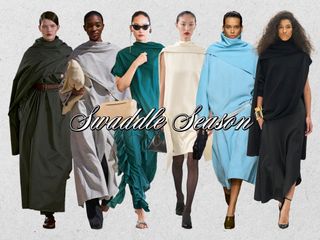
(Image credit: Launchmetrics Spotlight; PICTURED: Lovechild 1979 F/W 24; The Garment S/S 24; Carven S/S 25; Toteme S/S 25; Bottega Veneta F/W 24; Alaïa F/W 25)
Public service announcement: Funnel necks weren’t the only prominent neckline in recent collections. In fact, we’d go so far as to say that they exist as a small part of a broader trend that we’re calling “swaddle season”—i.e., the embrace of silhouettes that wrap around the body. Although slightly different in comparison to funnel necks, the swaddling trend has the same air of sophistication, just somewhat different in approach. Rather than focusing solely on the neck, this trend is embodied through draping techniques that cover a larger portion of the body. While some might attribute the rise of this trend to the popularity of the critically acclaimed show Feud: Capote vs. the Swans or even the general desire to be cozy once winter comes around, we know that there’s more to the story here. In truth, this wrapped silhouette has stood out in recent seasons because it is innately elegant—it can transform even the simplest or stalest staples into something else entirely.
There’s no better proof of that than the F/W 24 and S/S 24 collections, which brought previously popular outerwear trends (e.g., capes, funnel-neck jackets, or coats with built-in scarves) to a whole new level of posh. A prime example of how the wraparound silhouette levels up staples can be found in the fall and spring runway shows of Scandinavian brands Lovechild 1979 and The Garment. Both collections took timeless trenches and made them far more theatrical with tailoring, creating a draping detail across the chest reminiscent of capes. Similarly, we saw Bottega Veneta’s and Alaïa’s fall shows give simple turtlenecks a stunning spin with the addition of scarves draped around the shoulders. And then, there were Toteme’s and Carven’s spring shows, which made silk gowns even more sumptuous with built-in scarves that were long enough to billow in the wind behind models. No matter what kind of silhouette was adapted across collections, designers showed that nothing is more stylish than allowing oneself to be swaddled for the season.

(Image credit: Launchmetrics Spotlight; PICTURED: Tod’s F/W 24; Prada S/S 24; Max Mara F/W 24; Chanel F/W 24; Chloé F/W 24; Michael Kors S/S 25)
Fashion has always walked the fine line between practical and decorative. On the one hand, there’s no denying that we all need to wear clothing (unless you’re into the sheer look). But on the other hand, we don’t necessarily “need” to adopt every trend. But despite lack of necessity, style for many plays a pivotal role in how they express themselves, how they cultivate joy, and how they feel their best in everyday life. Of course, that doesn’t mean everyone sees it as a necessity, but that’s what makes one of the season’s most surprising trends all the more compelling: unnecessary belts. Unlike other accessory trends, designer belts have always been a practical part of any wardrobe, but F/W 24 and S/S 25 runways took them from pragmatic to idealistic and back again. It wasn’t just about having them hold up a baggy pair of jeans; it was about styling them in a way that makes a larger statement about personal style. It seemed that designers were showing us how this “unnecessary” accessory can make everyday items feel uniquely individual.
That’s evident everywhere, including Max Mara’s and Chanel’s fall runway shows, in which super-skinny belts were layered over black turtleneck sweaters. Similarly, at Michael Kors’s spring show, a black button-down shirt and crinkled satin midi skirt were styled with a slim black belt despite having no utility. Beyond examples of belts worn with looks that don’t require them, we also saw designers embrace more statement belts in general. For instance, Chemena Kamali’s debut fall show for Chloé featured sheer lace slip dresses and funnel-neck plaid capes adorned with gold chain belts in the shape of the house’s moniker. While at Tod’s fall show, sportswear separates were adorned with low-slung leather belts with car-inspired buckles. If that weren’t enough to prove our point, Miu Miu’s spring show buckled into that theme entirely—e.g., shiny patent-leather coats were given a personal touch by adding mismatched chain belts layered on top. With all these collections, belts were used to bridge the gap between functionality and fashion.

(Image credit: Launchmetrics Spotlight; PICTURED: Burberry F/W 24; Brandon Maxwell S/S 25; Bevza F/W 24; Tod’s S/S 25; Chloé F/W 24; Gucci S/S 25)
At first, it seemed like a fluke that funnel necks were making a comeback, but as they’ve slowly infiltrated the runways again, it’s clear they’re here to stay. What makes this neckline relevant again, besides the fact that it could be found throughout the F/W 24 and S/S 25 collections, is how far removed it’s become from the stuffier versions of the past. A far cry from the austere coats that first became popular in the 17th century, the funnel necklines this season were far more fun because designers got creative with colors, prints, textiles, and even styling. A prime example of this was Burberry’s F/W 24 collection, which featured trench coats with high necklines and furry cuffs—possibly the most flamboyant take on the trend. The version of this coat in Chloé’s F/W 24 collection was equally eye-catching, as it came in a neutral-hued plaid print that was styled over hot pants and knee-high boots. And then there was Gucci’s spring show, which featured a cropped funnel-neck bomber jacket in a punchy shade of green styled with matching shorts, sunglasses, and shiny pumps.
While Burberry, Gucci, and Chloé chose to use texture, color, and prints as a way to accentuate the neckline on their outerwear, Brandon Maxwell and Tod’s went a different route—specifically, they chose to deconstruct the silhouette. The typically funnel-neck coat transformed into a detachable dress made even cooler with the addition of tinted aviators and jelly sandals at Brandon Maxwell’s spring show. While at Tod’s spring show, the technicality of this coat was on full display in a well-tailored cropped iteration with a draped fold-over flap that created a cape-like element. But it wasn’t just reimagining this classic neckline in coat form that made it compelling. With Bevza’s fall collection, we saw crisply tailored camel, navy, and white blouses come with prominent funnel necklines too. Whether by styling or slight adaptions to the silhouette, designers made a serious case for becoming a funnelphile for the indefinite future.

(Image credit: Launchmetrics Spotlight; PICTURED: Altuzarra S/S 25; Coach S/S 25; Prada F/W 25; Chanel F/W 25; Chloé S/S 25; Markgong F/W 24)
By now, we’ve hopefully proved that some trends can make great long-term investments. However, if you still can’t wrap your head around that idea, allow us to discuss a trend that’s been on our minds lately: statement hats. Of course, no one would go so far as to claim that this accessory will somehow be brain-altering, because, being honest here, they’ve been around for centuries. However, we first began to see hats become a “trend” again when they bubbled up in the S/S 24 runway collections of The Row, Alaïa, and Prada. Ever since then, hats have been a steadfast part of recent seasons, but they’ve surfaced in every style imaginable. Baker caps, pillbox hats, baseball caps—they were all a big part of the F/W 24 and S/S 25 runway shows. But what makes this trend so compelling isn’t solely how designers embraced the accessory in droves; instead, it has to do with the fact that they used it as a way to draw attention to “everyday” items.
For example, classic-cut peacoats and crewneck sweaters popped out a bit more with the addition of feather-adorned caps in Prada’s fall collection. Similarly, Markgong’s fall show dialed up the contrast of a long maroon coat with a black leather cap. Even in Chanel’s fall show, long tweed coats, shearling jackets, and bouclé dusters stood out more despite being styled with matching baker caps. However, that approach wasn’t limited to fall shows, as we saw this accessory surface in the spring collections of Coach, Altuzarra, and even Chloé. Honestly, it’s rare for a trend these days to last three consecutive seasons, but it’s one of the few items that have become consistent across collections. Frankly, we get the appeal. There are very few ways to trick our minds into thinking those “mundane” things in our wardrobes feel new without a major overhaul, but this trend is one of them. Hats off (or, in this case, on) for the few trends that consistently hold that power.







